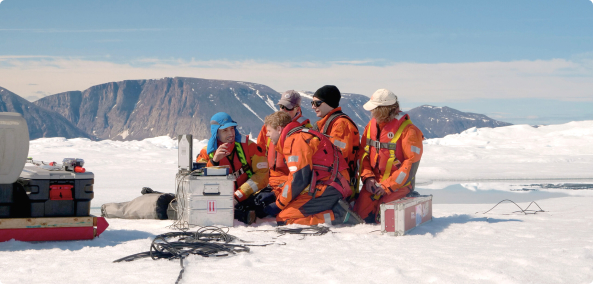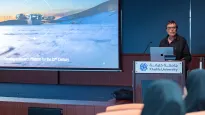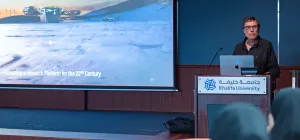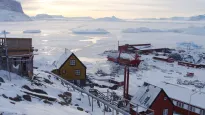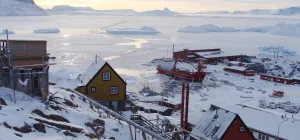Belgian-led Team of Researchers Bring Back Impressive Haul of Meteorites during Antarctic Research Expedition
An international team led by Belgian scientists has recovered 115 Antarctic meteorites weighing more than 2 kg (in total) during the ongoing 2024-2025 BELgian Antarctic Research Expedition (BELARE).
An international team led by Belgian scientists has recovered 115 Antarctic meteorites weighing more than 2 kg (in total) during the ongoing 2024-2025 BELgian Antarctic Research Expedition (BELARE).
While previous successful meteorite recovery missions in 2009-2010, 2010-2011, 2012-2013, 2018-2019, and 2022-2023 focused on blue ice areas closer to Belgium’s zero-emission Princess Elisabeth Antarctica station, the 2024-2025 campaign took place in the remote Belgica Mountains of Antarctica, more than 300 km southeast of the research station. In addition, the team also recovered several thousand micrometeorites, cosmic dust particles less than 2 mm in diameter, and abundant ice and rock samples. This research has been made possible through funding by the Belgian Science Policy (BELSPO) and required heavy logistical support from the International Polar Foundation (IPF), mandated to manage the Princess Elisabeth research station by the Belgian Polar Secretariat.
The meteorite search team, consisting of three scientists from Belgian universities - Prof. Dr. Steven Goderis of the Vrije Universiteit Brussel as well as Prof. Dr. Vinciane Debaille and Dr. Gabriel Pinto of the Université libre de Bruxelles, Brussels, Belgium), and Dr. Hamed Pourkhorsandi, a research scientist at the Institut de Recherche pour le Développement in France - together with two IPF field guides Martin Leitl and Paul-Philippe Dudas, made a first stop in the Balchenfjella area in search of meteorites, before making their way to the Belgica Mountains on December 15. The Belgica Mountains, located in the Queen Maud Land region in East Antarctica, were discovered by a Belgian expedition team during the International Geophysical Year Polar Expedition in 1958 during a reconnaissance mission by airplane. The reconnaissance had to be stopped after the airplane crashed on the blue ice there. The mountains were visited again by Belgian scientists in the 1960s, but have not been visited by a Belgian scientific team since then.
Meteorites can be found on blue ice fields near mountain chain where the ice is pushed up and eroded by strong katabatic winds. Systematic recovery programs have been running since the 1970s, as each meteorite holds relevant information about the formation and evolution of the solar system and the celestial bodies, including Earth, the Moon and Mars, as well as the arrival of water, volatile compounds, and organic matter to Earth, etc.
Prior plans for travel by container convoy had to be abandoned for air transport due to difficult terrain. Conditions at the basecamp (essentially tents) were harsh, even for Antarctic summer, with temperature going down to -31˚C with the wind chill due to strong winds. The team of researchers would head out each day looking for meteorites on snow mobiles in a V-shaped formation, so they could cover large areas more systematically.
More impressive than the number were the types of meteorites found. The meteorites included at least two achondrites (stony meteorite representing planetary mantles), and several carbonaceous chondrites, the most primitive meteorites similar in composition to the original material of the Solar nebula, the giant, spinning cloud of gas and dust that formed our solar system about 4.6 billion years ago.
“Each new (micro)meteorite provides an essential piece of the puzzle we are trying to solve,” said Prof. Goderis about the importance of the samples he and his colleagues found.
“Based on some meteorite fragments, we can learn about planetary differentiation and collisions taking place in the early solar system, and in other fragments we find prebiotic molecules required for the evolution of life.” added Prof. Debaille.
The meteorites will be sent to the Royal Belgian Institute of Natural Sciences in Brussels for defrosting, curation, and detailed classification, after which they will become available for research to the involved research teams as well as the international scientific community. The most beautiful pieces will be put on display for the public to enjoy.
Nederlands
Belgisch geleid team van onderzoekers brengt indrukwekkende vondst van meteorieten terug tijdens Antarctische expeditie
Een internationaal team, geleid door Belgische wetenschappers, heeft 115 meteorieten gevonden in Antarctica, met een gewicht van meer dan 2 kg, tijdens de lopende BELgian Antarctic Research Expedition 2024-2025 (BELARE).
Terwijl eerdere succesvolle missies waarin meteorieten werden gezocht in 2009-2010, 2010-2011, 2012-2013, 2018-2019 en 2022-2023 zich richtten op de blauwe ijskappen in de buurt van het Belgische zero-emissie Princess Elisabeth station in Antarctica, waar de Belgische onderzoeksteams zich vaak oriënteren en trainen voordat ze het veld ingaan, vond de campagne van 2024-2025 plaats in het afgelegen Belgica gebergte van Antarctica, meer dan 300 km ten zuidoosten van het onderzoeksstation. Bovendien vond het team ook verschillende duizenden micrometeorieten, kosmische stofdeeltjes van minder dan 2 mm in diameter, en een groot aantal stalen van ijs en gesteenten. Dit onderzoek werd mogelijk gemaakt door financiering van het Belgische Wetenschapsbeleid (BELSPO) en vereiste zware logistieke ondersteuning door het International Polar Foundation (IPF), die verantwoordelijk is gesteld voor het beheer van het Princess Elisabeth onderzoekstation door het Belgian Polar Secretariat.
Het meteoriet team, bestaande uit drie wetenschappers van Belgische universiteiten – Prof. Dr. Steven Goderis van de Vrije Universiteit Brussel, evenals Prof. Dr. Vinciane Debaille en Dr. Gabriel Pinto van de Université libre de Bruxelles, Brussel, België – en Dr. Hamed Pourkhorsandi, een onderzoekswetenschapper van het Institut de Recherche pour le Développement in Frankrijk, samen met twee IPF-veldgidsen Martin Leitl en Paul-Philippe Dudas, maakten een eerste stop in het Balchenfjella-gebied op zoek naar meteorieten, voordat ze op 15 december naar het Belgica gebergte reisden. Het Belgica gebergte, gelegen in de Koningin Maud Land regio in Oost-Antarctica, werd ontdekt door een Belgisch expeditie team tijdens de International Geophysical Year Polar Expedition in 1958, tijdens een verkenningsvlucht met vliegtuig. De verkenning moest echter worden gestopt nadat het vliegtuig daar op de blauwe ijskappen crashte. De bergen werden opnieuw bezocht door Belgische wetenschappers in de jaren '60, maar werden sindsdien niet meer bezocht door een Belgisch wetenschappelijk team.
Meteorieten kunnen worden gevonden op blauwe ijsgebieden, waar bedolven bergketens gletsjers omhoogduwen en het ijs wordt geërodeerd door sterke katabatische winden. Systematische zoekprogramma's lopen al sinds de jaren '70, aangezien elke meteoriet relevante informatie bevat over de vorming en evolutie van het zonnestelsel en de hemellichamen, waaronder de Aarde, de Maan en Mars, evenals de herkomst van water, vluchtige stoffen en organisch materiaal op Aarde, enzovoort.
Eerdere plannen om per containerkonvooi te reizen werden vervangen door transport via lucht vanwege moeilijk terrein. De omstandigheden in het basiskamp (in feite tenten) waren zwaar, zelfs voor de Antarctische zomer, met temperaturen die tot -31˚C daalden door de wind chill als gevolg van sterke winden. Het team van onderzoekers vertrok elke dag op zoek naar meteorieten met sneeuwscooters in een V-vormige formatie, zodat ze grote gebieden gemakkelijker konden dekken.
Imposanter dan het aantal meteorieten was de diversiteit aan soorten meteorieten die werden gevonden. De meteorieten omvatten ten minste twee achondrieten (stenige meteorieten die de mantels van andere planeten vertegenwoordigen) en verschillende koolstofrijke chondrieten, de meest primitieve meteorieten die qua samenstelling lijken op het oorspronkelijke materiaal van de zonnenevel, de enorme, draaiende wolk van gas en stof die ons zonnestelsel ongeveer 4,6 miljard jaar geleden vormde.
“Elk nieuw (micro)meteoriet biedt een essentieel stukje van de puzzel die we proberen te maken,” zei Prof. Goderis over het belang van de monsters die hij en zijn collega's vonden.
“Op basis van sommige meteorietfragmenten kunnen we leren over de planetaire differentiatie en botsingen die plaatsvonden in het vroege zonnestelsel, en in andere fragmenten vinden we prebiotische moleculen die nodig zijn voor de evolutie van leven,” voegde Prof. Debaille eraan toe.
De meteorieten zullen naar het Koninklijk Belgisch Instituut voor Natuurwetenschappen in Brussel worden gestuurd voor ontdooien, conservering en gedetailleerde classificatie, waarna ze beschikbaar worden gesteld voor onderzoek door de betrokken onderzoeksteams, evenals door de internationale wetenschappelijke gemeenschap. De mooiste stukken zullen worden tentoongesteld aan het publiek.
Français
Une équipe dirigée par la Belgique rapporte une impressionnante récolte de météorites lors d’une expédition de recherche en Antarctique
Une équipe internationale dirigée par des scientifiques belges a récupéré 115 météorites antarctiques pesant plus de 2 kg au cours de l'expédition en cours (2024-2025) de la BELgian Antarctic Research Expedition (BELARE).
Alors que les précédentes missions réussies de récupération de météorites en 2009-2010, 2010-2011, 2012-2013, 2018-2019 et 2022-2023 se concentraient sur des zones de glace bleue plus proches de la station antarctique belge zéro émission Princess Elisabeth, où les équipes de recherche belges s’orientent et s’entraînent habituellement avant de se rendre sur le terrain, la campagne 2024-2025 s’est déroulée dans les montagnes Belgica, à plus de 300 km au sud-est de la station de recherche. De plus, l’équipe a également récupéré plusieurs milliers de micrométéorites, des particules de poussière cosmique de moins de 2 mm de diamètre, ainsi que de nombreux échantillons de glace et de roches.
Cette recherche a été rendue possible grâce au financement de la Politique scientifique fédérale belge (BELSPO) et a nécessité un soutien logistique important de la Fondation polaire internationale (IPF), mandatée par le Secrétariat polaire belge pour gérer la station de recherche Princess Elisabeth.
L’équipe de recherche, composée de trois scientifiques d’universités belges - le Prof. Dr Steven Goderis de la Vrije Universiteit Brussel ainsi que la Prof. Dr Vinciane Debaille et le Dr Gabriel Pinto de l’Université libre de Bruxelles (ULB), et du Dr Hamed Pourkhorsandi, chercheur à l’Institut de Recherche pour le Développement en France - accompagnés de deux guides de terrain de l’IPF Martin Leitl et Paul-Philippe Dudas, a fait une première halte dans la région des Montagnes Balchen à la recherche de météorites avant de se rendre dans les montagnes Belgica le 15 décembre.
Les montagnes Belgica, situées dans la région de la Terre de la Reine-Maud en Antarctique oriental, ont été découvertes par une équipe d’expédition belge lors de l’Année géophysique internationale en 1958, au cours d’une mission de reconnaissance aérienne. Cette reconnaissance a dû être interrompue après le crash de l’avion sur la glace bleue. Les montagnes ont été visitées à nouveau par des scientifiques belges dans les années 1960, mais aucune équipe scientifique belge n’y était retournée depuis lors.
Les météorites peuvent être trouvées sur des champs de glace bleue où des chaînes de montagnes enfouies soulèvent les glaciers, et où la glace est érodée par les vents catabatiques puissants. Des programmes de récupération systématique sont en cours depuis les années 1970, car chaque météorite contient des informations précieuses sur la formation et l’évolution du système solaire et des corps célestes, y compris la Terre, la Lune et Mars, ainsi que sur l’arrivée de l’eau, de composés volatils et de matière organique sur Terre, entre autres.
Les plans initiaux de déplacement par convoi de conteneurs ont dû être abandonnés au profit du transport aérien en raison du terrain difficile. Les conditions au camp de base (essentiellement des tentes) étaient rudes, même pour l’été antarctique, avec des températures descendant jusqu’à -31 °C avec le refroidissement éolien dû aux vents forts. Chaque jour, les chercheurs partaient à la recherche de météorites en motoneige, formant une formation en V pour couvrir de vastes zones plus efficacement.
Plus impressionnants que le nombre, les types de météorites récupérées sont également remarquables. Parmi elles, au moins deux achondrites (météorites rocheuses représentant des manteaux planétaires) et plusieurs chondrites carbonées, les météorites les plus primitives, similaires en composition au matériau originel de la nébuleuse solaire, ce gigantesque nuage de gaz et de poussière qui a formé notre système solaire il y a environ 4,6 milliards d’années.
« Chaque nouvelle (micro)météorite fournit une pièce essentielle du puzzle que nous essayons de résoudre », a déclaré le Prof. Goderis au sujet de l’importance des échantillons trouvés par son équipe.
« À partir de certains fragments de météorites, nous pouvons en apprendre davantage sur la différenciation planétaire et les collisions qui ont eu lieu dans le jeune système solaire, et dans d’autres fragments, nous trouvons des molécules prébiotiques nécessaires à l’évolution de la vie », a ajouté la Prof. Debaille.
Les météorites seront envoyées à l’Institut royal des Sciences naturelles de Belgique à Bruxelles pour être décongelées, conservées et classifiées en détail, après quoi elles seront mises à disposition des équipes de recherche concernées ainsi que de la communauté scientifique internationale. Les plus belles pièces seront exposées au public.
Scientist contacts (Avaialble after 12/12/2024)
Professor Steven Goderis (e-mail: Steven.goderis@vub.be; phone: +32 473982917): Dutch, English
Professor Vinciane Debaille (e-mail: vinciane.debaille@ulb.be; phone: +32 486248232): French, English
Dr. Gabriel Pinto (e-mail: gabriel.angel.pinto.morales@ulb.be; phone: +32 465651643): English, Spanish, French
Dr. Hamed Pourkhorsandi (e-mail: hamed.pourkhorsandi@ird.fr; phone: +33 699448112): English, Persian, Azeri, Turkish, French
IPF PressContact
Joseph Cheek (e-mail: jcheek@polarfoundation.org)
About the International Polar Foundation (IPF) EN
The IPF is a public foundation, created in 2002 by Alain Hubert. Its remit is to support international polar scientific research. The IPF was also behind the creation of the Princess Elisabeth Antarctica station, which was officially opened in 2009 as the first and, to date, only zero-emission station, with a view to maintaining a Belgian presence in Antarctica and pursuing its ambition in service of citizens facing climate and environmental challenges. Every year, the Princess Elisabeth Antarctica station hosts numerous scientists of all nationalities.
Over de International Polar Foundation (IPF) NL
IPF is een Stichting van openbaar nut, opgericht in 2002 door Alain Hubert met wetenschappelijke persoonlijkheden uit de academische wereld. Haar missie is het ondersteunen van internationaal poolwetenschappelijk onderzoek. Ook was IPF initiatiefneemster van het station Princess Elisabeth op Antarctica, het eerste «zero emission» station, met het oog op het behoud van de Belgische Antarctische aanwezigheid en het nastreven van haar ambitie om burgers die met klimaat- en milieu -uitdagingen te maken hebben ten dienste te staan.
A propos de l'International Polar Foundation (IPF) FR
L’IPF est une fondation d’utilité publique créée en 2002 par Alain Hubert avec des personnalités scientifiques du monde académique. Elle a comme mission le soutien de la recherche scientifique polaire internationale. Elle est également à l’initiative de la station antarctique Princess Elisabeth, première station « zéro émission », en vue de préserver la présence antarctique belge et d’en poursuivre l’ambition au service des citoyens confrontés aux défis climatiques et environnementaux.
